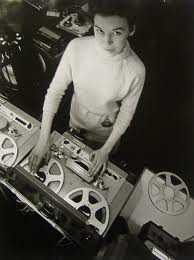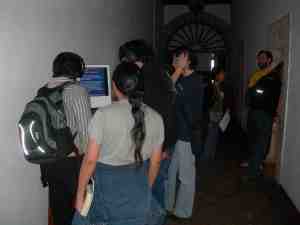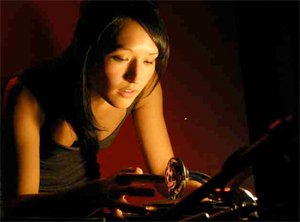 Despite being the woman responsible for the original Doctor Who theme tune Delia Derbyshire, one of Britain’s early electronic music pioneers, still rather unbelievably remains relatively unknown.
Despite being the woman responsible for the original Doctor Who theme tune Delia Derbyshire, one of Britain’s early electronic music pioneers, still rather unbelievably remains relatively unknown.
So much so in fact that many Mancunians don’t realise that the entire archive of her work is based in a centre just off one of their city’s the main traffic corridors.
Although not open for passing visitors due to it being manned by volunteers the archive, contained in the University of Manchester’s NOVARS Institute on Oxford Road, is accessible by appointment.
It was created in 2008 when the custodian of Delia Derbyshire’s collection, Mark Ayres, put it on permanent loan to a senior lecturer in Screen Studies, David Butler.
David’s challenge was to order and digitise the 267 tapes that had been found in her attic in cereal boxes with peeling labels after she died in 2001 to introduce her work to a much wider audience.
It was also hoped that the process of cataloguing the fragile 10.5” reels, some of which had not been played for over 40 years, would encourage more academic research.
Delia, an electro-acoustic composer and musician born in Coventry in 1937, worked tirelessly behind the scenes in the BBC’s Radiophonic workshop for 13 years from 1960.
Producing music anonymously for countless BBC productions including Dr Who she also collaborated outside of the studio with fellow workshop members to set up two outfits and studios called Kaleidophon and Unit Delta Plus.
What made her work so important was that she was producing some of the earliest modern electronic compositions in Britain.
Fascinated by everyday sounds, voices and white noise she recorded and electronically modified them before cutting, mixing and splicing her tapes to create different sound effects.
She would use studio equipment to loop and distort her sounds even further as well as experiment with square wave oscillators to help build intricately-timed rhythms to turn them into fully-fledged compositions.
Her ability to create such pioneering sounds led Grainer,who asked Delia to realise the score he had written for Doctor Who, to ask ‘did I really write that?’ when she played him the finished version.
It’s also the reason why so many electronic musicians such as Aphex Twin, Chemical Brothers and Pet Shop Boys have cited her as a major influence on their own work.
David, who worked in his spare time to digitise the tapes, is now involved in the task of trying to certify the authorship of the works so that the many lesser known tracks can be published to raise her public profile.
Yet it is a task not made easy by the fact that whilst some tracks have been verified as her own work other tapes, which were found with no labels, still have unknown origins.
David said: “Sorting the tapes has been quite an adventure to say the least.
“Whilst some were easy to identify we’ve found a lot either with no labels or confusing titles that don’t give us an indication as to whether she created the entire piece of music, co-authored it or if it’s even her work at all.
“Delia has a pretty distinctive sound so I’m quite confident that the vast bulk of tapes are her own work but we need concrete proof of this before we can publicly release them due to copyright restrictions.”
A trip to the archive or attending one of the infrequent Delia Derbyshire lectures and exhibitions is then the only way to listen to her amazing recordings.
 Whilst the original tapes are kept locked away in specially conditioned rooms the whole collection can now be heard digitally in David’s office.
Whilst the original tapes are kept locked away in specially conditioned rooms the whole collection can now be heard digitally in David’s office.
Meeting him there one Wednesday morning I am lucky enough to be treated to some of David’s personal favourites which he has lovingly turned into a 45 minute mix.
Amongst many extracts are snippets of what sounds like tense heart beats used in her score to Peter Hall’s production of Macbeth another which was used as part of in in another used for a programme in the radio series ‘Inventions for Radio’ called ‘Amor Dei’ she creates an incredible ethereal sound by warping a choir boy’s voice.
One of the stand-out extracts simply titled ‘Ron Grainer, Bread.’ It’s a convincing three and a half minute proto dance track created with a drum machine and synthesisers that David believes was written way before its time in around the early 1970s.
David said: “When I first heard it I rushed down the stairs to where it was being played because it’s so ahead of its t ime.
ime.
“It was never released so we’re not sure where it’s come from or why it was made.
“The short extract of that piece had such an effect when a snippet of it was legally broadcast that I started to get emails from djs from around the world who then turned it into eight minute long tracks.
“That alone tells you the level of skill involved in creating it.”
Talking about her archive afterwards he said: “Getting the chance to hear all her work has been incredible because I’ve been able to listen to music that I thought had been lost forever.
“It was loaned to the centre after I wrote what was basically a fan letter to mark who had started releasing cds from the Radiophonic Workshop asking if there was any chance of a re-issue of a Blake’s 7 release and asked if there was any way we at the university could help.
“He wrote back asking if we could help organise Delia’s archives so I jumped at the chance.
“Listening to the tracks you quickly realise that the most exciting thing about Delia’s work is that the sounds all around us have the potential to become music.
 “As well as influencing world class djs since creating the archive we’ve had a lot of interest from people who want to use her work to get kids involved in sound engineering.
“As well as influencing world class djs since creating the archive we’ve had a lot of interest from people who want to use her work to get kids involved in sound engineering.
“Although what she did was technically complex the techniques she used are accessible at a basic level to all.
“There are so many musical surprises contained in her work that are simply fascinating but Amor Dei is one that has probably influenced me the most.
“She’s used just one voice to create something incredibly diverse.
“She stretches his voice to create sounds that are so hauntingly beautiful and fragile which are contrasted sharply with more brutal rhythmic mash-ups a few seconds later.
“It takes everyday speech and transforms it into art and shows that everyone’s voice regardless of social class and background can become something poetic and musically wonderful.
“The range of sounds she created has already fascinated and inspired such a wide breadth of musicians from classical to electronica which is testament to the extent of her talents.
“My hope that is by bringing her to the attention of more people she will be able to encourage even more people into experimenting with everyday sounds.”
To find out more about her archive go to http://www.novars.manchester.ac.uk/research/delia.
